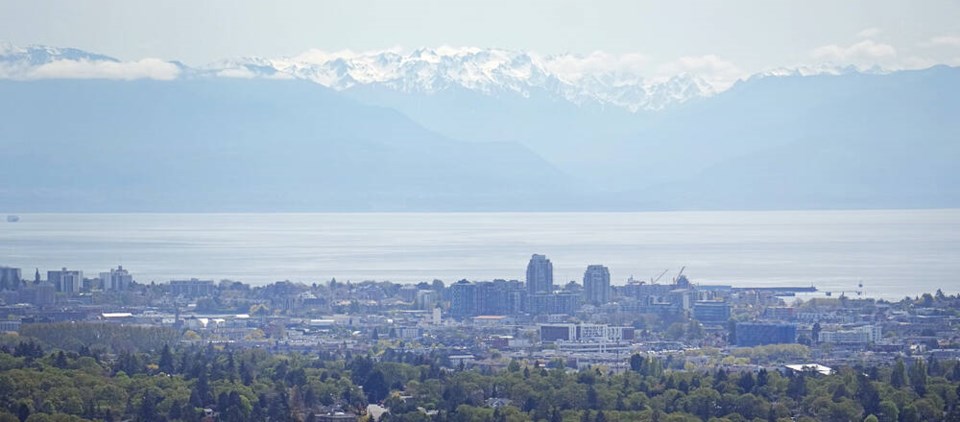One municipality’s police and fire services are “significantly over-taxed” while the other largely responds to less-stressful calls, a member told Saanich council

Saanich council heard Monday from members of a citizens’ assembly recommending a merger with Victoria, but is not expected to make any decisions until a municipal staff report on possible next steps.
Richard Mitchell, a Saanich resident who was part of the Victoria-Saanich Citizens’ Assembly, told council he believes there is a moral responsibility to share the tax burden of responding to the region-wide opioid crisis that’s most visible in parts of downtown Victoria.
Mitchell said he came to the assembly with the belief that amalgamation would save “bucketloads of money,” but quickly learned that merging the two communities would yield little in savings, although it would have other benefits.
One municipality’s police and fire services are “significantly over-taxed” while the other largely responds to less-stressful calls, said Mitchell, a retired Saskatchewan police officer. “Why is it that another community has access to better services?”
A shared police and fire service would also respond better to natural disasters, he said. “Based on those beliefs, we came to a conclusion that amalgamation was the best answer.”
Assembly member Ana Cortes, speaking independently of the assembly’s delegation to council, said deeper collaboration doesn’t mean the two municipalities have to become one.
“Saanich and Victoria are not the same. We each have our own identity, values and priorities. That difference matters and it’s something that we should protect, not merge away,” she said.
Adam Sherk, an assembly member who lives in rural Saanich with his wife and two children, said he came to the group with concerns about how rural and agricultural lands could be affected by amalgamation.
But Sherk said agricultural lands will continue to be protected by the province’s Agricultural Land Commission and “there was no reason to believe” that large rural parkland would be affected either.
Brenna Atnikov, an assembly member who lives four blocks from the Victoria-Saanich municipal border in Victoria, said she “wouldn’t really know the boundaries between the two” if they hadn’t been pointed out to her, adding she goes to the library and shops for groceries in Tillicum and spends a lot of time at Uptown shopping centre, both of which are in Saanich.
Atnikov, who moved to the Island from Calgary in 2021, said she wasn’t sure whether to support amalgamation until the end, but ultimately chose what she thought was the most forward-thinking model to tackle issues such as First Nations reconciliation, climate adaptation and the economy.
“For me, the citizens’ assembly was a rare but needed opportunity to collectively lift our gaze from the immediacy of the day-to-day concerns and urgency … to really think about what is the future of this place?” she said.
“What opportunities actually might pass us by if we don’t take a bold decision to grapple with the future and think about the place we can become if we were one?”
Assembly member Matthew Moodie, a student at the University of Victoria who was born and raised in Saanich, said he would be against a ward system if amalgamation happens, as research suggests people would use it to block developments and make the housing crisis worse.
Coun. Susan Brice questioned parts of the report that suggested an amalgamated municipality would have better transit, noting bus routes are run by a regional body, the Victoria Regional Transit Commission.
Coun. Judy Brownoff raised concerns that parts of Victoria’s infrastructure are now over a century old and would cost lots of money to replace.
Both Brice and Coun. Nathalie Chambers asked questions about whether Saanich’s urban containment boundary might change under amalgamation.
“The thought of an amalgamated [urban containment boundary] makes my blood boil,” said Chambers, who worried that an expanded boundary could mean the loss of farmland.
Just over half of Saanich is outside the boundary, but only around one-third of that area is designated as protected farmland.
Citizen assembly chair Peter MacLeod told council that amalgamation has been considered for decades — if not generations — in the region, noting that the question has been put to voters multiple times since 2014.
MacLeod said no one in the citizens’ assembly said they liked the status quo. Thirty-nine out of 46 members supported amalgamation, while seven wanted to keep Victoria and Saanich separate but supported deeper integration between the two, he said.
Victoria council will receive the amalgamation report on Thursday. Five members of the assembly are expected to speak at council.
The assembly is recommending that a referendum on amalgamation take place alongside the 2026 municipal election. If the referendum results are in favour of merging, the first elections for a unified municipality would occur in 2030.
In the 2014 municipal elections, eight of the region’s 13 municipalities put amalgamation-related questions on ballots. In the end, 75 per cent of voters were in favour of examining some kind of amalgamation.
Four years later, Victoria and Saanich residents voted in favour of establishing the citizens’ assembly to study amalgamation.
[email protected]